@BBCExtraGhost, #Vennfest, @UKGoHomeOffice and beyond – doing political satire for the web
It turns out, when I think about it, that I’ve spent rather a lot of my spare time and my career trying to do political satire on the web. And that’s why I was invited to talk about it at a recent BBC Question Time Watchalong event in London. Here’s roughly what I said. With slightly less swearing.
@BBCExtraGhost

I started @BBCExtraGhost in response to the BBC’s @BBCExtraGuest. I thought that was a missed social media opportunity. Instead of handing an extra voice at the BBC Question Time table to a member of the audience like the @sweden account does, the BBC picked as its first guest Toby Young. A man with a national newspaper column. I made @BBCExtraGhost based on the pun, showed it to one person, and then didn’t do anything with it. The following week by chance I walked by a blue plaque for obscure British PM Bonar Law, and once I’d finished thinking “Who? A 20th century Prime Minister I’ve never heard of?” I thought “He’s going to be my Question Time ghost. Disgruntled because nobody remembers him.”
So I started a weekly rotating cast of dead people tweeting along as if they were watching BBC Question Time from beyond the grave: William Morris, Arthur C Clarke, Emmeline Pankhurst, Nancy Astor, Robert Maxwell, Ted Heath. All of them appeared on the account. Incidentally, Nancy Astor is such an amazing character that she should be taught on the national curriculum.
Now, I say “appeared on the account”, what I mean is, I pretended to be them whilst sitting on my sofa with a can of beer shouting at the telly. Which seems, in hindsight, a little bit odd. And certainly sounded very odd when I said it out loud at the BBCQTWatchalong. I’d try and balance up the political and gender make-up of the panel with my guest, or pick someone who might have a topical angle, for example Robert Maxwell when some Leveson thing was kicking off, or Ted Heath when there were lots of rumours flying around about Conservative politicians on This Morning.
At the start it was really good fun. Essentially I had two jokes and one serious point. If the ghost was an old left-winger, they would bemoan the state of the modern Labour party and their betrayal of the working classes. If the ghost was an old right-winger, they would moan about immigration and that the present day Tories were too namby-pamby. So essentially, either pretending to be Owen Jones or Nigel Farage, but with a few more phrases from the early 20th century.
And a serious point – that none of the politicians on the panels these days have ever served in the forces, but have been happy to send our troops off to war. And none of them credit the EU with having kept Europe free of major conflict for several decades. Nearly everybody I impersonated, though, had played a role in at least one, if not two, World Wars.
One tedious aspect was that I found if the account was masquerading as a woman, it opened it up to misogynistic abuse. In fact I got a complaint that Emmeline Pankhurst was “all about feminism” before I had even attempted a single tweet in character. One night an MRA harangued me for about twenty minutes after the show had finished. I’m aware that an interesting philosophical debate about which of us was the lonelier, sadder specimen of a man might ensue at this point…
Actually the abuse when the account was posing as a woman eventually wore me down, and was one of the factors in deciding to stop. It gave me a renewed admiration for politically vocal women on social media who have to deal with this shit from men all the time, and who don’t have the option of glibly saying “And next week I’m going to be Arthur C. Clarke instead.”
And so the account fizzled out in a series of strange messages suggesting that the inhabitants of the after-life were becoming annoyed by the intrusion, and a vague promise of investigating some “technical difficulties”. There are still occasional @-messages asking if it is ever going to come back, which is really nice. It is always genuinely lovely if you are making something you hope people will find entertaining, and they say they miss it when you stop.
Due to interference in our Twitter feed over the last few days we will not have a @BBCExtraGhost tonight for #bbcqt. We are investigating.
— BBC Extra Ghost (@BBCExtraGhost) February 7, 2013
The Thatcher pie-chart
Meanwhile, something else had happened. Over the Christmas holidays I had tweeted a pie chart predicting what Twitter would look like on the day Margaret Thatcher died. It proved very popular, and generated hundreds of retweets. When she did die, the chart resurfaced and that number increased to thousands.
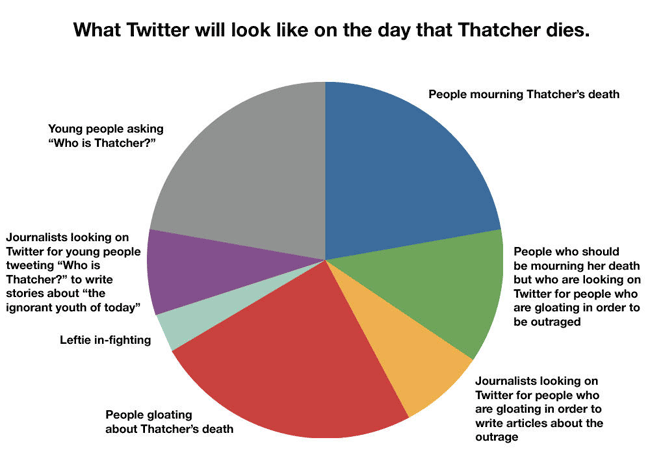
It made me think that there was potential in “amusing” political infographics. In the way that the “cartoon” and the “Parliamentary sketch” have long been standard formats for criticism of politicians, maybe the web could distribute charts and graphics that did the same thing? So I set out to cover BBC Question Time using live infographics, with a clear focus on the Venn diagram.
#Vennfest
When I started doing #Vennfest, I didn’t know if it would work, or indeed if I’d be able to keep it up for a whole episode of the show. The idea was essentially to lay political jokes over the format of a Venn diagram. The punchline would be in the intersection of the two sets.
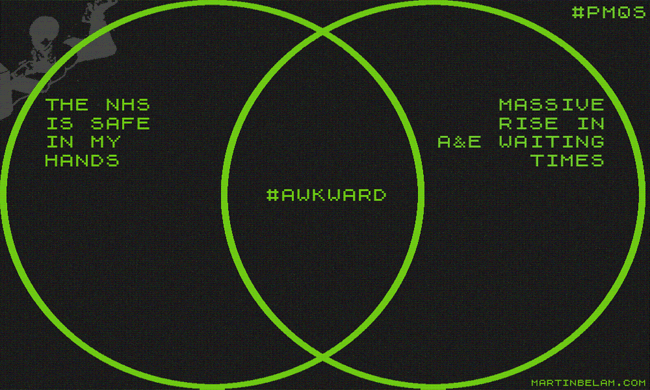
Preparation was key. I’d make a Photoshop document with layers that had as the punchline all the names of the people on the panel, phrases like “#Awkward” and “Tumbleweed”, things that were likely to be mentioned like “The EU” or “The BBC”, and obvious potential punchlines that could work on any episode like “Nigel Farage” or “Nick Clegg’s promises.” I’d also research each person on the panel, so that I was armed with information on any gaffes or ridiculous expenses claims they’d been involved in.
I found that most of the #Vennfest diagrams would generate favourites and retweets on Twitter, and that I was gaining a couple of hundred followers with each transmission. Quite what these people made of the stuff I tweeted during the rest of the week remains unknown.
The tiresome pedantry of the long distant internet runner
One curse during #Vennfest was the number of people tweeting at me that the diagrams were not technically correct as Venn diagrams. It drove me up the wall. It seemed to me self-evident that they were a joke on top of two circles, not a mathematical assertion of fact. That was part of the schtick. But, you know, maths pedants, eh?
The complaints sucked the joy a little out of doing it, and I was also worrying about it becoming a chore. I’d find myself clock-watching on a Thursday night, trying to cram stuff into my evening and fretting about getting the prep in. Or suddenly fleeing a night out in order to get home to do it. So I thought I’d quit whilst I was ahead, and declared the last episode of the last series of BBC Question Time the #Vennfest finale. I had a few people message to say they hoped I’d reconsider, which was again lovely, and at least a couple of them weren’t my mum, but I was also beginning to get introduced at parties as “the Venn diagram guy”, and I’m still after a better epitaph than that.
The last #Vennfest diagram was, of course, my favourite. This.
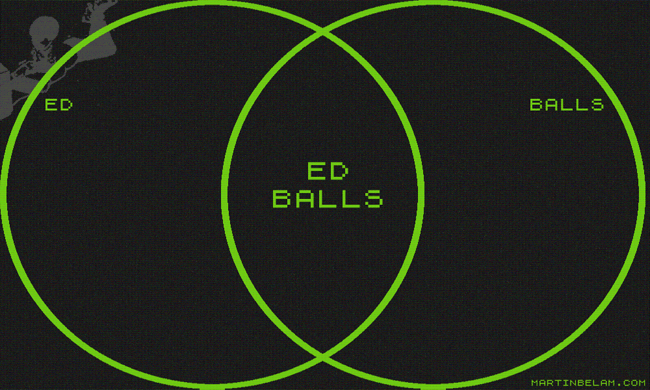
I thought I’d find a new live-tweeting angle for BBC Question Time in preparation for the next series, but in the meantime, again, something else cropped up…
@UKGoHomeOffice
I wasn’t very impressed with the UK Home Office “Racist van”, which appeared to be a politicised attempt to generate a load of PR around a campaign to send immigrants home, with a couple of vans that actually just went round white working class areas.
And I was doubly unimpressed when the UK Home Office Twitter account started live tweeting a day of operations against suspected illegal migrants, accompanied by pictures of mostly non-white suspects being hashtagged #immigrationoffenders.
We’ve got due process in this country, I don’t think you should be labelled an “offender” until you’ve been found guilty, and I don’t think the communication channels that belong to the civil service should be sending out party political messages and demonising people who aren’t white.
So I made @UKGoHomeOffice.
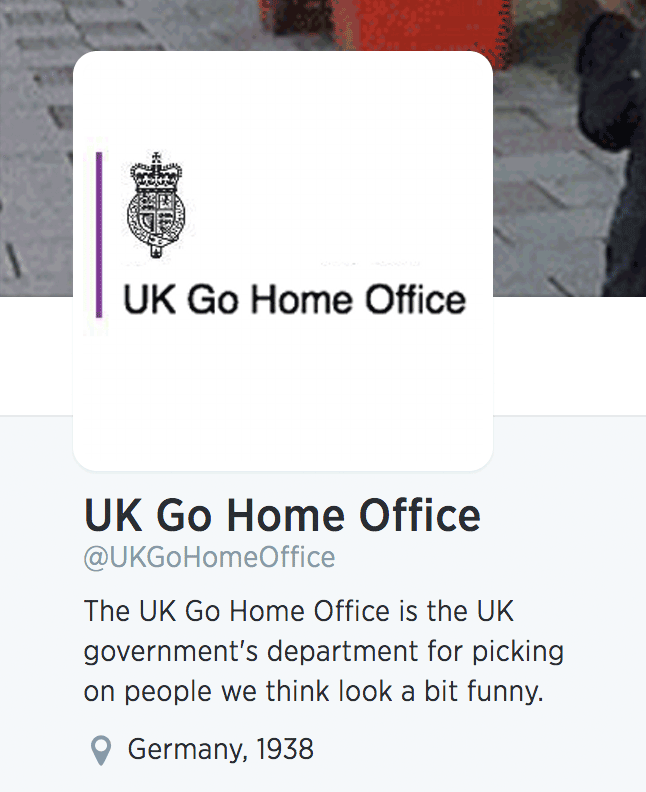
Now I have to say at this point, that if you are aware of Rule 34—If it exists, there is porn of it—I’d like to make you aware of Rule 34a: If it exists, there is a lame Twitter parody account of it. I loathe lazy Twitter parodies, I think if you are going to do one then you really need to craft it.
With @UKGoHomeOffice I really concentrated on quality of tweets rather than quantity. I had a document to draft and refine tweets in advance, and set myself a limit of two or three tweets a day. This approach seemed to pay off, as with just 12 tweets the account had amassed over a thousand followers, and individual tweets—like one suggesting you should text “I’M A BIT RACIST” to the Home Office number to support their campaign—got hundreds of retweets.
I also went a bit further with making supporting material. I designed leaflets that a real UK Go Home Office might give to immigration suspects, densely packed with bleak humour about the way the British media and authorities demonise foreigners. Instead of just posting the leaflet to social media, I crumpled it up and dropped it in a puddle, took a photo of that, and then had the account issue a tweet criticising #immigrationoffenders for being litter louts. Closer inspection of the image would reveal what had been dropped.
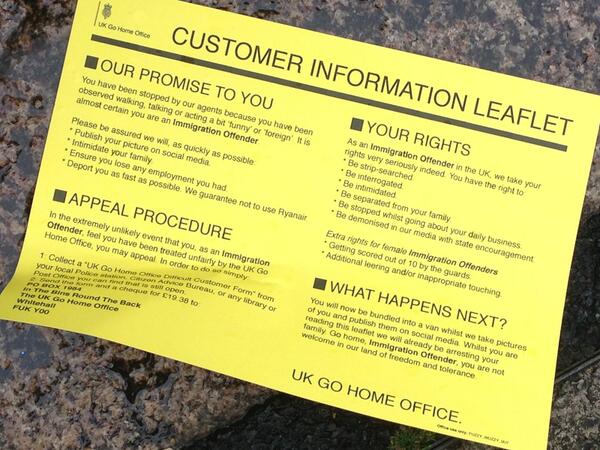
I really enjoy making parodies that work on several levels, although, if you are mocking racist behaviour, you are always likely to fall foul of another internet law: Poe’s Law: “Without a blatant display of humor, it is impossible to create a parody of extremism or fundamentalism that someone won’t mistake for the real thing.”
Somebody reported the account to the Met Police on Twitter for racism. I was unclear whether they really thought the parody was racially offensive, or whether they hadn’t realised that it was a parody, and were actually trying to report the Home Office itself. Which would be quite recursive.
And someone else complained when the account quoted Snow’s “Informer” that it was mocking gun crime. YMMV.
After an initial couple of weeks of activity, the account now occasionally tweets if the “Racist van” is back in the news, but has otherwise lapsed into a dormant state—even when being invoked by someone who is running an account representing UKIPPER Godfrey Bloom’s Bongo Bongo Land.
UsVsTh3m
UsVsTh3m is a site that I’ve helped set up and launch for Trinity Mirror. The idea is to produce very shareable social content, that is funny, and often topical. One thing we’ve recently excelled in is publishing some quick satirical political games.
Iain Duncan Smith’s Realistic Unemployment Simulator saw you take the role of a guy trudging between the job centre, interviews, voluntary work picking litter, and home again. Increasingly fast time intervals bring home just how futile and dispiriting the government’s plans for unemployed youths are. And all the while, Iain Duncan Smith brays what a jolly good lark it all is. It brings home the impact much more closely than a 1,000 word analysis piece ever will. It was put together in about a day, and launched to coincide with him standing up to speak at the Conservative Party Conference. We tweeted it, including the conference hashtag, hoping to make a point to a wider audience.
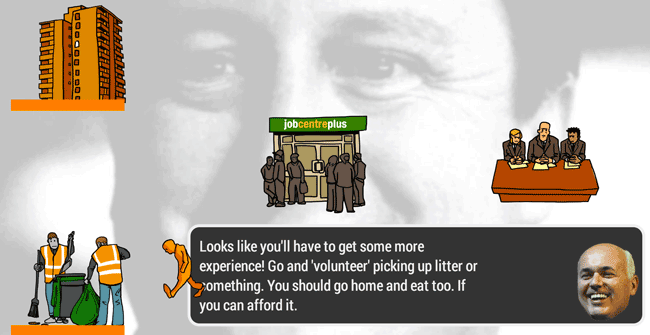
Super Tory Boy had been much longer in the planning, and takes pixel versions of leading Conservative politicians through a heavily Mario-influenced landscape as they platform game their way through crushing workshy peasants, privatising services, and raking in cash donations. Matt Round was the genius behind this.

A more off-the-cuff game was Owen Paterson’s Badger Penalty Shootout, which Tom Scott got built and launched within a couple of hours of the minister’s gaffe that ‘Badgers had moved the goalposts’ when it came to assessing whether the controversial cull of the creatures had been a success.

And our “How much are you hated by the Daily Mail” quiz rode the coat-tails of the Ralph Miliband controversy, took a couple of hours to write and produce, and was played by more people than Alastair Campbell could get to sign his Paul Dacre petition.
I think there is an interesting lesson for both media companies and politicians here. What we are tapping into is a way for people to express a sympathy for a political position in a light-hearted and amusing way, which isn’t making them come across as looking earnest about politics. And sharing it also makes them look like they know where to find cool stuff on the internet. It is a world away from a political party producing a poster with bad typography and a clumsy slogan, and then asking people to ‘Like’ it on Facebook whilst giving them nothing in return.
Next…
I don’t know what is next, but I’m helping Trinity Mirror run a new project—Mysterious Project Y—and I’m hoping some of the things I’ve learned about trying to be funny-and-shareable in near-real-time to political events I can turn towards being serious-and-shareable in near-real-time plus also “data”. We’ll see.
UPDATE: Mysterious Project X, of course, became Ampp3d.
With huge thanks to Natalie Guest who organises #qtwatch and invited me along to talk, without which I would not have written this.